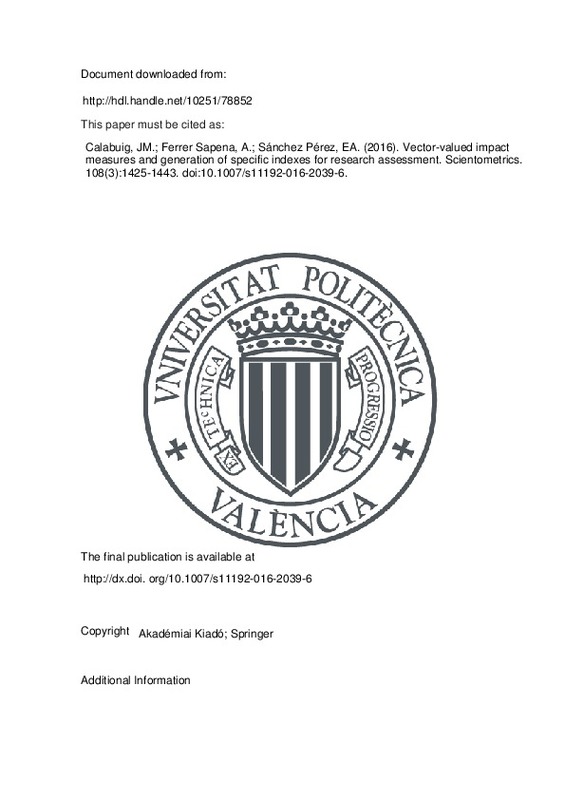Aleixandre Benavent, R., Valderrama Zurián, J. C., & González Alcaide, G. (2007). Scientific journals impact factor: Limitations and alternative indicators. El Profesional de la Información, 16(1), 4–11.
Alguliyev, R., Aliguliyev, R. & Ismayilova, N. (2015). Weighted impact factor (WIF) for assessing the quality of scientific journals. arXiv:1506.02783
Beauzamy, B. (1982). Introduction to Banach spaces and their geometry. Amsterdam: North-Holland.
[+]
Aleixandre Benavent, R., Valderrama Zurián, J. C., & González Alcaide, G. (2007). Scientific journals impact factor: Limitations and alternative indicators. El Profesional de la Información, 16(1), 4–11.
Alguliyev, R., Aliguliyev, R. & Ismayilova, N. (2015). Weighted impact factor (WIF) for assessing the quality of scientific journals. arXiv:1506.02783
Beauzamy, B. (1982). Introduction to Banach spaces and their geometry. Amsterdam: North-Holland.
Beliakov, G., & James, S. (2011). Citation-based journal ranks: the use of fuzzy measures. Fuzzy Sets and Systems, 167, 101–119.
Buela-Casal, G. (2003). Evaluating quality of articles and scientific journals. Proposal of weighted impact factor and a quality index. Psicothema, 15(1), 23–25.
Diestel, J., & Uhl, J. J. (1977). Vector measures. Providence: Am. Math. Soc.
Dorta-González, P., & Dorta-González, M. I. (2013). Comparing journals from different fields of science and social science through a JCR subject categories normalized impact factor. Scientometrics, 95(2), 645–672.
Dorta-González, P., Dorta-González, M. I., Santos-Penate, D. R., & Suarez-Vega, R. (2014). Journal topic citation potential and between-field comparisons: The topic normalized impact factor. Journal of Informetrics, 8(2), 406–418.
Egghe, L., & Rousseau, R. (2002). A general frame-work for relative impact indicators. Canadian Journal of Information and Library Science, 27(1), 29–48.
Ferrer-Sapena, A., Sánchez-Pérez, E. A., González, L. M., Peset, F. & Aleixandre-Benavent, R. (2016). The impact factor as a measuring tool of the prestige of the journals in research assessment in mathematics. Research Evaluation, 1–9. doi: 10.1093/reseval/rvv041 .
Ferrer-Sapena, A., Sánchez-Pérez, E. A., González, L. M., Peset, F., & Aleixandre-Benavent, R. (2015). Mathematical properties of weighted impact factors based on measures of prestige of the citing journals. Scientometrics, 105(3), 2089–2108.
Gagolewski, M., & Mesiar, R. (2014). Monotone measures and universal integrals in a uniform framework for the scientific impact assessment problem. Information Sciences, 263, 166–174.
Habibzadeh, F., & Yadollahie, M. (2008). Journal weighted impact factor: A proposal. Journal of Informetrics, 2(2), 164–172.
Klement, E., Mesiar, R., & Pap, E. (2010). A universal integral as common frame for Choquet and Sugeno integral. IEEE Transactions on Fuzzy Systems, 18, 178–187.
Leydesdorff, L., & Opthof, T. (2010). Scopus’s source normalized impact per paper (SNIP) versus a journal impact factor based on fractional counting of citations. Journal of the American Society for Information Science and Technology, 61, 2365–2369.
Li, Y. R., Radicchi, F., Castellano, C., & Ruiz-Castillo, J. (2013). Quantitative evaluation of alternative field normalization procedures. Journal of Informetrics, 7(3), 746–755.
Moed, H. F. (2010). Measuring contextual citation impact of scientific journals. Journal of Informetrics, 4, 265–277.
Owlia, P., Vasei, M., Goliaei, B., & Nassiri, I. (2011). Normalized impact factor (NIF): An adjusted method for calculating the citation rate of biomedical journals. Journal of Biomedical Informatics, 44(2), 216–220.
Pinski, G., & Narin, F. (1976). Citation influence for journal aggregates of scientific publications: Theory, with application to the literature of physics. Information Processing and Management, 12, 297–312.
Piwowar, H. (2013). Altmetrics: Value all research products. Nature, 493(7431), 159–159.
Pudovkin,A.I., & Garfield, E. (2004). Rank-normalized impact factor: A way to compare journal performance across subject categories. In Proceedings of the 67th annual meeting of the American Society for Information science and Technology, 41, 507-515.
Rousseau, R. (2002). Journal evaluation: Technical and practical issues. Library Trends, 50(3), 418–439.
Ruiz Castillo, J., & Waltman, L. (2015). Field-normalized citation impact indicators using algorithmically constructed classification systems of science. Journal of Informetrics, 9, 102–117.
Torra, V., & Narukawa, Y. (2008). The h-index and the number of citations: Two fuzzy integrals. IEEE Transactions on Fuzzy Systems, 16, 795–797.
Waltman, L., & van Eck, N. J. (2008). Some comments on the journal weighted impact factor proposed by Habibzadeh and Yadollahie. Journal of Informetrics, 2(4), 369–372.
Waltman, L., & van Eck, N. J. (2010). The relation between Eigenfactor, audience factor, and influence weight. Journal of the American Society for Information Science and Technology, 61, 1476–1486.
Zahedi, Z., Costas, R., & Wouters, P. (2014). How well developed are altmetrics? A cross-disciplinary analysis of the presence of ’alternative metrics’ in scientific publications. Scientometrics, 101(2), 1491–1513.
Zitt, M. (2010). Citing-side normalization of journal impact: A robust variant of the Audience Factor. Journal of Informetrics, 4(3), 392–406.
Zitt, M. (2011). Behind citing-side normalization of citations: Some properties of the journal impact factor. Scientometrics, 89, 329–344.
Zitt, M., & Small, H. (2008). Modifying the journal impact factor by fractional citation weighting: The audience factor. Journal of the American Society for Information Science and Technology, 59, 1856–1860.
Zyczkowski, K. (2010). Citation graph, weighted impact factors and performance indices. Scientometrics, 85(1), 301–315.
[-]







![[Cerrado]](/themes/UPV/images/candado.png)


